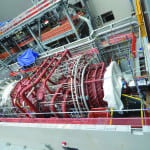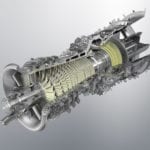GE Power’s CEO on March 4 said his company sees the global gas turbine market stabilizing, in part due to better accessibility to natural gas worldwide.
Scott Strazik made the comment during GE’s Investor Outlook on Wednesday. The event is an annual overview of the company’s operations that GE gives to investment professionals. The outlook provided details on the company’s varied business units, noting the power division showed “signs of progress” as it pulled back costs and improved its profit margins. (Go here to listen to the presentation.)
“Last year, we shared that power is on a multi-year journey, this still holds true,” said Strazik. He added that “both gas power and the power portfolio need to do better.”
GE CEO Larry Culp in the presentation said the company in total expects to see an impact of $300 million to $500 million on its first-quarter free cash flow due to the coronavirus, with most of that affecting the company’s aviation group. “We entered this year with momentum, having diligently addressed our most pressing issues and reset our foundation in 2019,” Culp told investors. “While there’s more work ahead, I am confident in our ability to execute, given the strengths of GE’s team, technology, and global reach and capabilities.”
Strazik said the market for gas turbines—which has struggled mightily in recent years as global orders dropped amid the worldwide growth in renewable energy—has stabilized. He cited data that noted there were 39 GW of large gas turbine orders worldwide in 2019, a jump from 29 GW in 2018. Strazik said the 2019 orders included 16 GW for GE turbines, up from 10 GW in orders in 2018. GE, Siemens, and Mitsubishi Hitachi Power Systems—the largest global turbine manufacturers—have each faced challenges in the turbine market in recent years.
Gas Turbines Replacing Coal, Nuclear
Strazik said the orders for gas turbines were driven by power generators looking for replacements for coal-fired and nuclear generation. He said the growth in the use of liquefied natural gas (LNG) worldwide also had a positive impact. Strazik said GE had 18 orders for its HA units in 2019, and said that overall the company expects to ship 45-50 gas turbines in 2020, up from 38 in 2019. He said the power group cut its fixed costs by 10% in 2019, partly by reducing the division’s workforce by about 2,000. He said another 10% cut in fixed costs is expected this year.
GE on Feb. 26 announced it had for the first time achieved a black start of a heavy-duty gas turbine using energy storage. GE said the black start was of a GE 7F.03 gas turbine in a 150-MW simple cycle unit at Entergy Louisiana’s Perryville Power Station. The Perryville facility is supported by GE’s 7.4-MW battery-based energy storage system paired with the plant’s simple cycle gas turbine. (Read “A Brief History of GE Gas Turbines” at powermag.com)
Russell Stokes, CEO of GE’s Power Portfolio, a group that includes steam turbines, power conversion, and nuclear energy products, said the company will continue to focus on profitable markets in marine, oil and gas, and other segments. He said GE would cut costs in the steam turbine business partly by moving manufacturing to “lower-cost” regions, as it continues to adapt to a new energy landscape.
“Given the realities around coal, the team is actively adapting its business strategy, focusing on global opportunities to grow in nuclear and biomass with the market’s best-in-class steam turbine,” said Stokes.
—Darrell Proctor is a POWER associate editor (@DarrellProctor1, @POWERmagazine).









